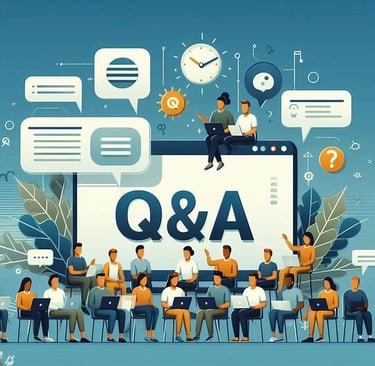Q&A
Let's Ace the Q&A session
Jeff Mildon
1/2/20242 min read


Got Questions? Let's Ace the Q&A!
Ever heard the saying, "It ain't over till it's over"? Well, that holds true for your presentation—it's not over until you've aced the Q&A session. Here are some friendly tips on how to tackle this often-critical aspect of your presentation.
Why are questions and your responses so important?
Questions make your presentation interactive. They give you a chance to connect with your audience, address their concerns, and even learn more about them. It's an opportunity to showcase your quick thinking and reinforce your message.
What's the best way to prepare for questions?
Anticipate potential questions related to your presentation and those stemming from your audience analysis. Prepare responses, especially for the toughest ones. Even if there's no formal Q&A session planned, be ready for those unexpected questions that might pop up.
Once the questions start coming, what should you do?
Listen carefully, go beyond the surface, and understand the full question before responding. If you're unsure, ask for clarification. Be straightforward, and if you don't know the answer, admit it and offer to follow up.
What types of questions—or questioners—should you be wary of?
Watch out for those who may dominate the session, give mini speeches, have their own agenda, or ask irrelevant questions. Keep control by responding to the first question, and then involving others. If someone misses a point, repeat it briefly without embarrassment.
How do you handle hostile questions?
Prevent them by addressing potential disagreements in your presentation. Don't put the questioner on the defensive; focus on the issues, stick to the facts, and find areas of agreement.
What if there are no questions?
Encourage discussion by revisiting a key point. Ask for opinions and create a comfortable space for one-on-one questions at the end of the session.
Are there other techniques that help?
Responding to questions is still presenting. Maintain eye contact, listen without interrupting, and keep a neutral stance. End your answers by shifting your focus to others in the room.
What's the best kind of answer?
Short. Simple. Concise.
Let the questioner finish their question.
In the world of Q&A sessions, an often overlooked yet crucial aspect is the art of letting the questioner finish their question, regardless of whether you already know the answer or not. Interrupting can unintentionally convey impatience or a lack of attentiveness. Allowing the questioner to express their inquiry in its entirety sends a powerful message—you value their input, listened attentively, and genuinely want to understand their perspective. This practice not only fosters a positive and respectful atmosphere but also enhances the credibility of your response. By refraining from jumping in prematurely, you set the stage for a thoughtful and well-received answer, demonstrating that your engagement goes beyond mere formality. So, the next time a question is posed, embrace the art of patience, let the questioner have the floor, and watch how it elevates the overall dynamics of your Q&A interaction.
A final note.
Responding to questions is as crucial as crafting and delivering your presentation. Don't let fumbling in the Q&A session damage your credibility—apply these tips and shine!
